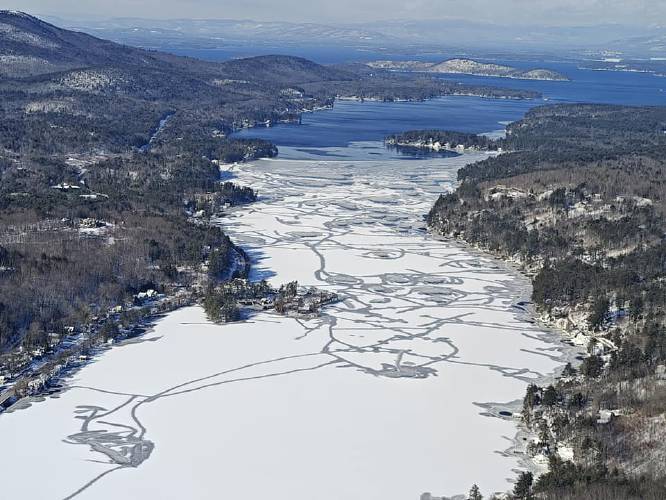“Ice-in” on Lake Winnipesaukee declared Friday, the latest date on record

Temperatures have been mild this winter, and with a lot of open water on Lake Winnipesaukee. Emerson Aviation
|
Published: 02-11-2024 8:00 AM
Modified: 02-11-2024 11:07 AM |
If you’re waiting for one of the signs that winter has finally arrived in New Hampshire – the declaration of “ice-in” at Lake Winnipesaukee – it’s been touch and go all season.
“I’m thinking this year we’re not going to see it,” said Dave Emerson of Emerson Aviation in Gilford, who has been giving the designation for a decade. “There’s no arctic air I can see in the forecast.”
On Friday, Feb. 9, Emerson saw enough ice and declared “ice-in” the latest date on record to do so. How long it lasts is anyone’s guess.
It almost didn’t happen last year until a blast of polar air hit on Feb. 3, dropping temperatures to 20 degrees below zero. Even so, that was the latest ice-in declaration on record.
The lack of ice is not only getting in the way of pond hockey, ice-fishing derbies and the opening of the unique ice runway for small planes in Alton Bay, which won’t happen for the second year in a row, but it’s also getting in the way of repairs and maintenance for homes on the lake’s islands.
“A couple contractors invested in some airboats, so if the lake ice was thin they could still get out on the ice. But this year with the open water, they’re not even attempting that,” said Emerson. Regular boats can’t be used because there’s too much ice along the shoreline to launch them from docks.
Contractors along the lake have seen a surge in another type of business, he said: Pulling out ATVs and even pickups that have fallen through the ice after they were driven onto the lake by optimistic, or perhaps foolhardy, owners.
The 45th annual Ice Fishing Derby is still happening this weekend on Winnipesaukee and many other lakes, but officials are telling people to be extra cautious.
Article continues after...
Yesterday's Most Read Articles
 Concord may finally buy long-closed rail line with hopes of creating city-spanning trail
Concord may finally buy long-closed rail line with hopes of creating city-spanning trail
 New Hampshire targets sexual exploitation and human trafficking inside massage parlors
New Hampshire targets sexual exploitation and human trafficking inside massage parlors
 State rules Epsom must pay open-enrollment tuition to other school districts, despite its refraining from the program
State rules Epsom must pay open-enrollment tuition to other school districts, despite its refraining from the program
 New Cheers owners honor restaurant’s original menu while building something fresh
New Cheers owners honor restaurant’s original menu while building something fresh
 Remembered: Friends recall stories about the lives of those who died without housing
Remembered: Friends recall stories about the lives of those who died without housing
 A look ahead at the ‘preferred design’ for Concord’s new police headquarters
A look ahead at the ‘preferred design’ for Concord’s new police headquarters
Participants are urged to wear inflatable life vests and carry ice picks, so if they fall through the ice, they will stay afloat and can pull themselves out easily.
The decline of “wild ice” on New Hampshire’s lakes and ponds has been occurring for years as winters warm and the climate changes.
“It used to be not uncommon to see 3 (or) 4 feet of ice on the lake,” said Emerson, 62, who was born in Wolfeboro. He was taught to fly by his father, who would take him out to practice takeoffs and landings on the frozen Lake Winnipesaukee. “The last time I saw 3 feet of ice was 2012.”
The problem with lake ice forming isn’t just warm weather, he said. Another obstacle is erratic precipitation, agitating the surface and making it harder for ice to form. In December, for example, New Hampshire had two snowstorms, each followed by heavy rain.
“All that running water funneled down into the lake and brought the lake level up. There was more (water) movement, the dam opened in Lakeport, the rivers and streams that run into the lake were rushing. It’s spring-fed as well, which acts as a bubbler. With the warmer temperature, all this contributed,” Emerson said.
Emerson said it’s easy to tell the condition and thickness of ice from a plane that is 1,500 feet above the surface once you know what you’re looking for, even to know what is black ice and what is black water.
“We have a flight school; we use the lake as our practice area, so we have a bird’s-eye view. We can tell the difference; we’ve seen that even on the calmest days, you’ll see a little bit of ripple where water is. And there’s a white ring where water and ice meet, so you can see that,” he said.
Ice-in means most of the lake is frozen, but ice-out just means the MS Mount Washington boat can make it to its five ports of call and navigate around its usual route. Emerson has made the call since 2018; it usually happens in the first or second week of April.







 ‘A little piece of everything I like’: New Pittsfield barbershop brings more than a haircut to downtown
‘A little piece of everything I like’: New Pittsfield barbershop brings more than a haircut to downtown NH judge decides to pause Trump’s birthright citizenship order
NH judge decides to pause Trump’s birthright citizenship order Canterbury honors ‘real heroes’ with updated Military Veterans’ Project
Canterbury honors ‘real heroes’ with updated Military Veterans’ Project Look, up in the sky! It’s… an Airstream trailer?
Look, up in the sky! It’s… an Airstream trailer?
